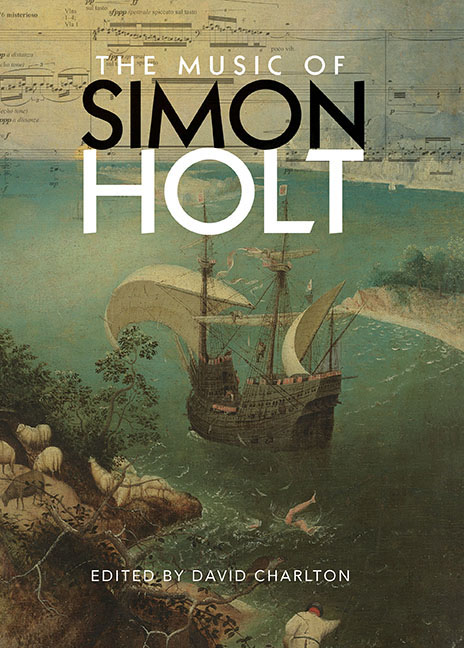Book contents
- Frontmatter
- Contents
- Figures and Tables
- Contributors
- Preface and Acknowledgements
- Abbreviations, with a note on recordings and scores
- Introduction Memories of Magical Moonlight: Simon Holt's years as a composition student
- 1 Duende y Duelos: The Andalusian spirit in the Lorca settings
- 2 An Interplay of Passion and Spirit: The Nightingale's to Blame
- 3 Images in Sound: Movement, harmony and colour in the early music
- 4 Myth and Narrative in 3 for Icarus
- 5 Sound, Sense and Syntax: The Emily Dickinson settings
- 6 Piano Music
- 7 Redefining the Cello's Voice: Musical agency in feet of clay
- 8 Performance and Reflections: Holt's music for oboe and cor anglais
- 9 Shaking the Bars: The Yellow Wallpaper
- 10 Listening to the River's Roar: Stance, texture and space in the concertos
- 11 Orchestral Works in Performance
- 12 Oblique Themes and Still Centres: A conversation between
- 13 Sketching and Idea-Gathering
- 14 Art, Conceptualism and Politics in Holt's music
- Appendix A Overview and Catalogue of Pieces
- Appendix B Texts by Simon Holt for Raju Raghuvanshi is a ghost and The Legend of Melusine
- Bibliography
- Index of pieces by Simon Holt
- General index
14 - Art, Conceptualism and Politics in Holt's music
Published online by Cambridge University Press: 01 September 2018
- Frontmatter
- Contents
- Figures and Tables
- Contributors
- Preface and Acknowledgements
- Abbreviations, with a note on recordings and scores
- Introduction Memories of Magical Moonlight: Simon Holt's years as a composition student
- 1 Duende y Duelos: The Andalusian spirit in the Lorca settings
- 2 An Interplay of Passion and Spirit: The Nightingale's to Blame
- 3 Images in Sound: Movement, harmony and colour in the early music
- 4 Myth and Narrative in 3 for Icarus
- 5 Sound, Sense and Syntax: The Emily Dickinson settings
- 6 Piano Music
- 7 Redefining the Cello's Voice: Musical agency in feet of clay
- 8 Performance and Reflections: Holt's music for oboe and cor anglais
- 9 Shaking the Bars: The Yellow Wallpaper
- 10 Listening to the River's Roar: Stance, texture and space in the concertos
- 11 Orchestral Works in Performance
- 12 Oblique Themes and Still Centres: A conversation between
- 13 Sketching and Idea-Gathering
- 14 Art, Conceptualism and Politics in Holt's music
- Appendix A Overview and Catalogue of Pieces
- Appendix B Texts by Simon Holt for Raju Raghuvanshi is a ghost and The Legend of Melusine
- Bibliography
- Index of pieces by Simon Holt
- General index
Summary
INTRODUCTION
NEVER LESS THAN INDIVIDUAL in his creative position, Simon Holt always offers new bridges between personal language, musical forms and the sister arts. These relate to his originality as a musical thinker about visual art, poetry and the drama of performance. Through such connections, Holt has found new ways of conceptualising music. Since his music cannot be described simply as ‘conceptual’, my title uses an older word, formerly tied to materialist debates. But it is intended to evoke conceptual art.
Conceptual Art: Term applied to work produced from the mid-1960s that either markedly de-emphasized or entirely eliminated a perceptual encounter with unique objects in favour of an engagement with ideas …. It examined the role of artistic intention in relation to the meanings ascribed to the resulting objects.
Holt's music regularly questions the meanings we might ascribe to the ‘objects’ which he offers. He is very particular in not wishing to compose ‘works’; he suggests ‘pieces’. There is evidence that the music which he hears and writes exists as a kind of object which is not wholly made of music. Furthermore, any metaphysical quality in his art has had various consequences at different times, since his music shifts periodically: ‘[As] a body changes its cells completely once every seven years I probably change my material’. In discussion with Julia Bardsley (Chapter 12, pp. 253–4) the composer clarified part of what I have labelled ‘conceptualism’:
I wouldn't call myself a composer in the traditional sense. I'm just someone who is trying to make work that happens to involve sound and instruments and people playing it – that's very important for me. It's not an academic exercise; I'm not interested in that, I'm interested in the sculptural aspect of it and the work almost becoming physical – in the moment – like it's an object that we're actually watching. So I'm trying to make something that seems sculptural. It's very physical to me.
Any resulting tensions in a finished piece, however, may well not be apparent as such: Holt is not nakedly experimental. He distances himself from Cage but aligns himself with Feldman: Cage, said Holt, ‘was forever asking “Why” … He was asking the same question as Feldman, but Feldman made music out of it’; the latter composer thus represents ‘a yardstick’.
- Type
- Chapter
- Information
- The Music of Simon Holt , pp. 284 - 304Publisher: Boydell & BrewerPrint publication year: 2017

